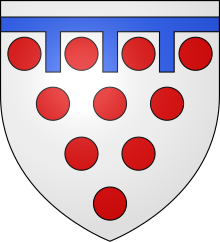Babington (noble family)

Babington (sometimes Babbington) is a noble English and Anglo-Irish family descended from Sir John de Babington, lord of the manor house of Babington (now Bavington in Northumberland ), who lived in 1178. The family were primarily landowners in Derbyshire (Dethick Inheritance), Northumberland, Leicestershire , County Cork , County Donegal and County Londonderry . Family seats were Rothley Court, Dethick Manor, Creevagh House, Roe Park House, Chilwell Hall, Curborough Hall, and Packington Hall. The family members regularly held offices such as high sheriff , lord lieutenant or were members of parliament.
history
Sir John de Babington, Lord of Babington, was mentioned in a document in the county of Northumberland in 1178. The family had resided there since the Norman Conquest of 1066. Sir John de Babington, a great-grandson of the previous Sir John, was chief captain of Morlaix in Brittany during the reign of King Edward III. and is buried in the Morlaix monastery . His son of the same name, Sir John de Babington, is said to have pronounced in Norman French: “Foy est tout” (“Faith is everything”) after he was chosen by King Henry IV for a difficult task. This became the motto of gender. His son Thomas Babington of Dethick fought for King Henry V at the Battle of Azincourt . His own son, Sir John Babington of Dethick , fell on the side of Richard III at the Battle of Bosworth in 1485 . Anthony Babington of Dethick was executed in 1586 as the main culprit in the unsuccessful Babington conspiracy to assassinate Queen Elizabeth I. The mineral babingtonite is named after the physician and mineralogist William Babington . After the botanist Charles Cardale Babington , the foxtail plant Kahle Melde is also called Babingtons Melde .
Well-known representatives
- John Babington (around 1423–1485), English knight, lord of Dethick
- Anthony Babington (1561–1586), Catholic nobleman, chief culprit in the Babington conspiracy
- William Babington (1756–1833), British medic and mineralogist (namesake of Babingtonite )
- Charles Cardale Babington (1808–1895), British botanist and archaeologist
- Churchill Babington (1821–1889), British clergyman, classical philologist, archaeologist, botanist and biologist
- Carlos Babington (born 1949), Argentinian football player
literature
- John Bowyer: Collectanea Topographica and Genealogica , Volume VIII, Nichols & Son London 1843.
- J. Bernhard Burke: A Genealogical and Heraldic Dictionary of the Landed Gentry of Great Britain and Ireland , Volume I, Colburn & Co, London 1752.
- John Burke: A Genealogical and Heraldic History of the Commoners of Great Britain and Ireland , Volume IV, Herny Colburn, London 1838.
Individual evidence
- ^ The Genealogy of the family of Babington of Dethick by GG
- ↑ Copographica Genealogica, Vol VIII, John Bowyer Nichols and Son. BABINGTONIA.
- ↑ Burke's Irish Landed Gentry by Bernard Burke, 'Babington of Creevagh', p. 42
- ↑ Brian Morris (Ed.): Burke's Peerage . Boydell & Brewer, Oxford 1999, Volume 1, p. 228.
- ^ Pedigree of Babington of Dethick . In: rotherhamweb.co.uk . Archived from the original on April 12, 2016. Info: The archive link was inserted automatically and has not yet been checked. Please check the original and archive link according to the instructions and then remove this notice. Retrieved December 30, 2016.
- ^ Bernard Burke: The General Armory of England, Scotland, Ireland, and Wales
- ↑ George Edward Cokayne (Ed.): The Complete Peerage . Alan Sutton Publishing, Gloucester 2000, Volume III, p. 154.
- ^ Dethick - Dethick Village - Peak District Villages - Peak Village - Derbyshire . In: peakdistrictonline.co.uk . Retrieved December 30, 2016.
- ^ William Durrant Cooper: Notices of Anthony Babington, of Dethick, and of the conspiracy of 1586. In: Reliquary. No. VIII, April 1862.